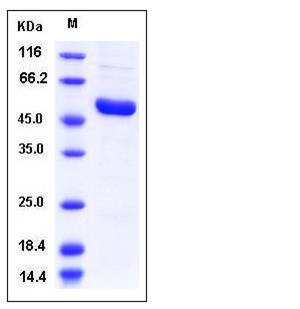Human IRAK4 / IRAK-4 Protein (His Tag)
IPD1,IRAK-4,NY-REN-64,REN64
- 100ug (NPP4028) Please inquiry
| Catalog Number | P10735-H07B |
|---|---|
| Organism Species | Human |
| Host | Baculovirus-Insect Cells |
| Synonyms | IPD1,IRAK-4,NY-REN-64,REN64 |
| Molecular Weight | The recombinant human IRAK4 consists of 478 amino acids and predicts a molecular mass of 53.8 kDa. It migrates as an approximately 48 kDa band in SDS-PAGE under reducing conditions. |
| predicted N | Met |
| SDS-PAGE |  |
| Purity | > 92 % as determined by SDS-PAGE |
| Protein Construction | A DNA sequence encoding the full length of human IRAK4 (Q9NWZ3-1) (Met 1-Ser 460) was expressed with a polyhistidine tag at the N-terminus. |
| Bio-activity | The specific activity was determined to be 169 nmol/min/mg using MBP as substrate. |
| Research Area | Immunology |Signal Transduction |Akt Pathway |Intracellular Kinases in the Akt Pathway |
| Formulation | Supplied as sterile 20mM Tris, 500mM NaCl, 0.5mM PMSF, pH 7.4 1. Normally 5 % - 8 % trehalose, mannitol and 0.01% Tween80 are added as protectants before lyophilization. Specific concentrations are included in the hardcopy of COA. |
| Background | Interleukin-1 receptor-associated kinase 4, also known as Renal carcinoma antigen NY-REN-64, IRAK-4 and IRAK4, is a member of the protein kinase superfamily, TKL Ser/Thr protein kinase family and Pelle subfamily. IRAK4 contains one death domain and one protein kinase domain. IRAK4 is required for the efficient recruitment of IRAK1 to the IL-1 receptor complex following IL-1 engagement, triggering intracellular signaling cascades leading to transcriptional up-regulation and mRNA stabilization. It also phosphorylates IRAK1. A member of the IL-1 receptor (IL-1R)-associated kinase (IRAK) family, IRAK4, has been shown to play an essential role in Toll-like receptor (TLR)-mediated signaling. IL-1-mediated IRAK4 kinase activity in T cells is essential for induction of IL-23R expression, Th17 differentiation, and autoimmune disease. Pharmacological blocking of IRAK4 kinase activity will retain some levels of host defence, while reducing the levels and duration of inflammatory responses, which should provide beneficial therapies for sepsis and chronic inflammatory diseases. Defects in IRAK4 are the cause of recurrent isolated invasive pneumococcal disease type 1 (IPD1) which is defined as two episodes of IPD occurring at least 1 month apart, whether caused by the same or different serotypes or strains. Recurrent IPD occurs in at least 2% of patients in most series, making IPD the most important known risk factor for subsequent IPD. Defects in IRAK4 are also the cause of IRAK4 deficiency which causes extracellular pyogenic bacterial and fungal infections in otherwise healthy children. |
| Reference |
